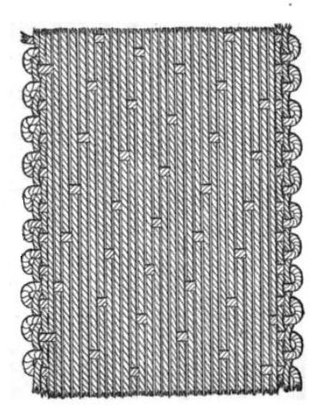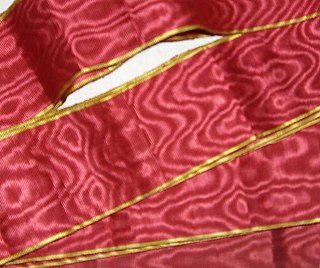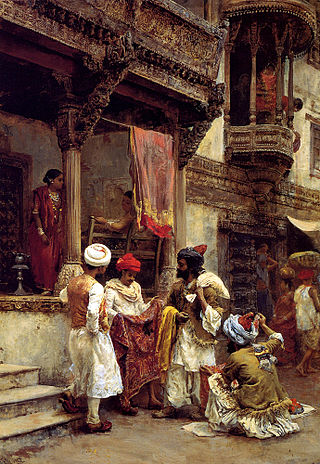Related Research Articles

A gambeson is a padded defensive jacket, worn as armour separately, or combined with mail or plate armour. Gambesons were produced with a sewing technique called quilting. They were usually constructed of linen or wool; the stuffing varied, and could be for example scrap cloth or horse hair. During the 14th century, illustrations usually show buttons or laces up the front.

Textile is an umbrella term that includes various fiber-based materials, including fibers, yarns, filaments, threads, different fabric types, etc. At first, the word "textiles" only referred to woven fabrics. However, weaving is not the only manufacturing method, and many other methods were later developed to form textile structures based on their intended use. Knitting and non-woven are other popular types of fabric manufacturing. In the contemporary world, textiles satisfy the material needs for versatile applications, from simple daily clothing to bulletproof jackets, spacesuits, and doctor's gowns.

A satin weave is a type of fabric weave that produces a characteristically glossy, smooth or lustrous material, typically with a glossy top surface and a dull back; it is not durable, as it tends to snag. It is one of three fundamental types of textile weaves alongside plain weave and twill weave.

Poplin, also called tabinet, is a fine wool, cotton or silk fabric that has a vertical warp and a horizontal weft. Nowadays, the name refers to a strong material in a plain weave of any fiber or blend, with crosswise ribs that typically give a corded surface.

Serge is a type of twill fabric that has diagonal lines or ridges on both inner and outer surfaces via a two-up, two-down weave. The worsted variety is used in making military uniforms, suits, greatcoats, and trench coats. Its counterpart, silk serge, is used for linings. French serge is a softer, finer variety. The word is also used for a high-quality woven woolen fabric.

A blanket is a swath of soft cloth large enough either to cover or to enfold most of the user's body and thick enough to keep the body warm by trapping radiant body heat that otherwise would be lost through convection.

Flannel is a soft woven fabric, of various fineness. Flannel was originally made from carded wool or worsted yarn, but is now often made from either wool, cotton, or synthetic fiber. Flannel is commonly used to make tartan clothing, blankets, bed sheets, and sleepwear.

Fustian is a variety of heavy cloth woven from cotton, chiefly prepared for menswear. It is also used figuratively to refer to pompous, inflated or pretentious writing or speech, from at least the time of Shakespeare. This literary use is because the cloth type was often used as padding, hence, the purposeless words are fustian.

Kiswa is the cloth that covers the Kaaba in Mecca, Saudi Arabia. It is draped annually on the 9th day of the month of Dhu al-Hijjah, the day pilgrims leave for the plains of Mount Arafat during the Hajj. A procession traditionally accompanies the kiswa to Mecca, a tradition dating back to the 12th century. The term kiswa has multiple translations, with common ones being 'robe' or 'garment'. Due to the iconic designs and the quality of materials used in creating the kiswa, it is considered one of the most sacred objects in Islamic art, ritual, and worship.

Crêpe, also spelled crepe or crape is a silk, wool, or synthetic fiber fabric with a distinctively crisp and crimped appearance. The term "crape" typically refers to a form of the fabric associated specifically with mourning. Crêpe was also historically called "crespe" or "crisp".

Broadcloth is a dense, plain woven cloth, historically made of wool. The defining characteristic of broadcloth is not its finished width but the fact that it was woven much wider and then heavily milled in order to shrink it to the required width. The effect of the milling process is to draw the yarns much closer together than could be achieved in the loom and allow the individual fibres of the wool to bind together in a felting process, which results in a dense, blind face cloth with a stiff drape which is highly weather-resistant, hard wearing and capable of taking a cut edge without the need for being hemmed.
Camlet, also commonly known as camlot, camblet, or chamlet, is a woven fabric that might have originally been made of camel or goat's hair, later chiefly of goat's hair and silk, or of wool and cotton. The original form of this cloth was very valuable; the term later came to be applied to imitations of the original eastern fabric.
The manufacture of textiles is one of the oldest of human technologies. To make textiles, the first requirement is a source of fiber from which a yarn can be made, primarily by spinning. The yarn is processed by knitting or weaving, which turns yarn into cloth. The machine used for weaving is the loom. For decoration, the process of colouring yarn or the finished material is dyeing. For more information of the various steps, see textile manufacturing.

Grosgrain is a type of fabric or ribbon defined by the fact that its weft is heavier than its warp, creating prominent transverse ribs. Grosgrain is a plain weave corded fabric, with heavier cords than poplin but lighter than faille, and is known for being a firm, close-woven, fine-corded fabric. Grosgrain has a dull appearance, with little luster in comparison to many fabric weaves, such as satin, often used for ribbons; however, it is comparatively very strong. Grosgrain fabric is most commonly available in black, but grosgrain ribbon comes in a large variety of colors and patterns. The ribbon is very similar to Petersham ribbon in its appearance, but it does not have the ability to follow the curves of a surface or edge the way that the latter does.

Moire, less often moiré, is a textile with a wavy (watered) appearance produced mainly from silk, but also wool, cotton and rayon. The watered appearance is usually created by the finishing technique called calendering. Moire effects are also achieved by certain weaves, such as varying the tension in the warp and weft of the weave. Silk treated in this way is sometimes called watered silk.

Piece goods were the textile materials sold in cut pieces as per the buyer's specification. The piece goods were either cut from a fabric roll or produced with a certain length, also called yard goods. Various textiles such as cotton, wool, silk, etc., were traded in terms of piece goods. The prices were determined as per the fabric quality.

Mashru is a woven cloth that is a blend of silk and cotton. It was historically a hand-woven satin silk fabric variety found in the Indian subcontinent, and its proper use is described in the 16th-century Ain-i-Akbari.
Bure was an old heavy woolen woven cloth that has undergone many changes since the Middle Ages. Hence, It was called with many names such as Bura, Burel, Burian, Burly, Burlesque, Burratto, Bournous, Burratine.

Scouring is a preparatory treatment of certain textile materials. Scouring removes soluble and insoluble impurities found in textiles as natural, added and adventitious impurities, for example, oils, waxes, fats, vegetable matter, as well as dirt. Removing these contaminants through scouring prepares the textiles for subsequent processes such as bleaching and dyeing. Though a general term, "scouring" is most often used for wool. In cotton, it is synonymously called "boiling out," and in silk, and "boiling off."
A blend is a mixture of two or more fibers. In yarn spinning, different compositions, lengths, diameters, or colors may be combined to create a blend. Blended textiles are fabrics or yarns produced with a combination of two or more types of different fibers, or yarns to obtain desired traits and aesthetics. Blending is possible at various stages of textile manufacturing. The term, blend, refers to spun fibers or a fabric composed of such fibers. There are several synonymous terms: a combination yarn is made up of two strands of different fibers twisted together to form a ply; a mixture or mixed cloth refers to blended cloths in which different types of yarns are used in warp and weft sides.
References
- 1 2 Cannon, Garland Hampton; Kaye, Alan S. (1994). The Arabic Contributions to the English Language: An Historical Dictionary. Otto Harrassowitz Verlag. p. 150. ISBN 978-3-447-03491-3.
- 1 2 Solalinde, Jesusa Alfau de (1939). Names of Textiles in Thirteenth Century Spanish. University of Wisconsin--Madison. p. 13.
- ↑ Mazzaoui, Maureen Fennell (1981-07-09). The Italian Cotton Industry in the Later Middle Ages, 1100-1600. CUP Archive. p. 199. ISBN 9780521230957.
- ↑ Glick, Thomas F. (2005). Islamic And Christian Spain in the Early Middle Ages. BRILL. p. 140. ISBN 978-90-04-14771-3.


